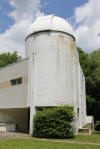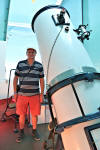
 |
Norman Lockyer Observatory,
Sidmouth Devon.
In August 2015 I visited this historic observatory during their annual open
day and astronomy fair. I would strongly recommend a visit here. The site
has several domes housing some historic telescopes, including two from the
nineteenth century, one being a 10" refractor which dates back to the Royal
College of Science in London (the precursor to Imperial College) where
Norman Lockyer set up an observatory. There is also a 6" refractor from a
similar date and a more modern 20" reflector. The site also has an excellent
planetarium. The annual astronomy fair attracts lots of visitors and also
has a marquee with displays etc. |
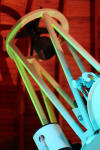 |
Auckland Astronomical Society.I visited
here in June 2014. The observatory is part of a complex called the
Stardome Observatory.
I managed to see some of the southern skies. Click for more details and
photos. |
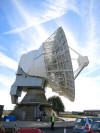 |
Chilbolton
Observatory. This is located quite close to where I live and is an
interesting observatory with a mixture of radio telescopes and weather
equipment. They only open for special open days, which you must book. The
main instrument is a 25m fully steerable dish, which these days is used for
weather research. Recently (2010) they installed a LOFAR radio telescope.
They have low and high frequency versions, which are linked with other
instruments around the world.
|
 |
Meteor Crater, Arizona. The
world’s best preserved meteorite impact site just minutes from Interstate 40
in Northern Arizona near Winslow. Meteor Crater is the result of a collision
between a meteor traveling at 26,000 miles per hour and planet Earth
approximately 50,000 years ago. The Crater is nearly one mile across, 2.4
miles in circumference and more than 550 feet deep.
|

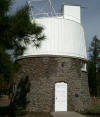 |
Flagstaff,
Arizona. Situated over 8000' high the
Lowell observatory at Flagstaff is where Pluto was discovered in 1930.
The observatory was built in 1894 by Percival Lowell. He spent his first
years there drawing what he believed to be canals — evidence of intelligent
life on Mars. Lowell was wrong about that, but he was right that the Solar
System extended beyond Neptune. He didn’t live to see the discovery of Pluto
here in 1930, although he did inspire the search for it. Pluto was
discovered by Clyde Tombaugh on February 18, 1930. |

 |
The
Somerset Space Walk. Situated on the towpath of the Bridgwater to
Taunton Canal. The 'Somerset Space Walk' is a scale model (530 million:1) of
the Solar System centred around the 'Sun' at Maunsel lock with the planets
located along the towpath in both directions. The Space Walk was designed by
local man, Pip Youngman, in order to demonstrate the scale of the Solar
System in an interactive way. The trail can be walked either from Taunton's
Brewhouse Theatre to Maunsel Lock (Pluto to the Sun) or from Bridgwater's
Morrison's Supermarket to Maunsel Lock (also Pluto to the Sun) or of course,
vice versa. From Pluto to the Sun from either town is an 11 kilometres (6.8
mi) walk. The positions of the Planets are marked by stones like the ones on
the left. |
 |
Herschel Museum,
19 New King Street, Bath. The home of famous astronomer William Herschel
(1738-1822).
From this house Herschel discovered Uranus. |









